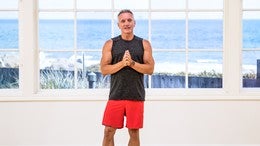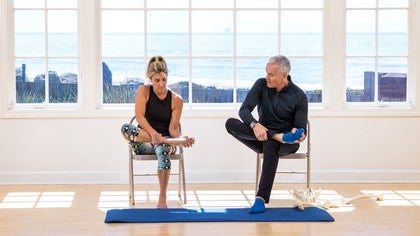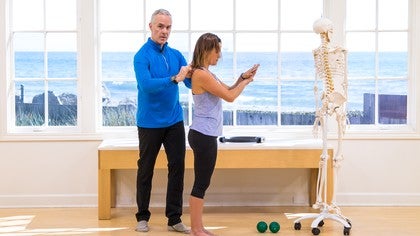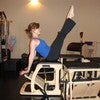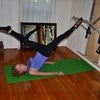Description
About This Video
Transcript
Read Full Transcript
Hi, I'm Tom McCook, I'm here at Pilates Anytime and I'm here to talk today about how I teach. It's been cultivated over a long time. I've been teaching for over 30 years and it's, like all of us who are teaching, I believe it continues to morph, and grow, and change, based on what I see people need and based on how my understanding grows. Currently, what I've been teaching for the last 12 years in combination with Pilates, is incorporating the Franklin Method of teaching people how the body is designed, so they can understand and learn how to self correct and teach themself. In that regard, if a student understands their body better and how it's designed to function, then they can actually be inside of a movement and get the most out of it, and improve their health, their well being, and have a great movement experience.
And for me, that's actually more important than the information that I'm giving them, their experience so they can actually take that away and do it with anything their doing in their life, and look forward to moving, and enjoy it more, and get more from it. In terms of helping people to move better and get more from their movement practices, it's important to understand for me anyway, why. What do we do as human beings all the time? We relate to gravity, we breathe, we move and we use our mind. We need to understand each one of those a little bit so we can know if the way we're thinking, the way we're moving, the way we're breathing, is it optimal or not.
Otherwise, we're gonna be at a little bit of a deficit and not really know if what we're doing is optimal or not. For our body to last a lifetime, it becomes pretty important the older we get. There's three primary things that we do to impede function. Number one, we have poor posture. We need to look at the lifestyles, people sit most of the day, not their fault, that's just the nature of the world.
So, if you're sitting all day, you're gonna have some muscular imbalances, and your relationship to gravity is impaired. Number two, we have excess tension. When you have excess tension you can't sense your body is well, and it's harder to actually self correct. Number three, is we move in a way that's against the design, meaning that our biomechanics are a little bit off. And if they're a little bit off, we're gonna put more ware and tare in the wrong places and typically it's our joints.
Our joints, usually we don't care about 'em till they hurt. That's kind of a problem. If you teach people how to do what we do all the time better, walk stand, lift your knees, move your spine, breathe, think in ways that support your health and well being, you are upgrading every system in their body. And for me, that's really what I'm doing as a teacher, that's my goal anyway, as a teacher for myself and my clients, that we both come out of the class feeling better. So, how do I start with somebody?
When somebody comes in, I'm making an assessment like every teacher is, the minute they walk in I'm making my general assessments of their posture, their tension levels, their current condition, how they communicate with me, what they're telling me they wanna improve. A lot of times people come in 'cause they got body ailments, they got pain, they got discomfort. Pain tends to be the number one motivator for a lot of us in our lives. On top of that, I'm asking them what they wanna improve? And then, I'm gonna do some assessments.
They're gonna be static assessments where I just look at them in posture and gravity, and then I'm gonna do a movement assessment where I let them movements reveal what's going on in their body. You know, in the past I might of had somebody lay down and start breathing, 'cause that's what I learned from my Pilates training, not that it's bad but it's hard to assess somebody when they lay down. If they do some basic movements of all their joints, you can actually see things that are gonna give you some insight and information about what's gonna be useful in their sessions, of where the weak areas are. I'm looking for what are the lowest grade places first and then build a lesson around that as that's their primary thing that we need to upgrade and then build it into a general lesson of full body conditioning. And their homework's gonna be related to the assessment of where they're basically, you could score it on a grade of one to three, one being low, where they have their ones, where their low scores were.
I wouldn't give 'em too much, one or two exercises for their lower areas and then once those areas upgrade, you reassess the whole body again. That way, you're getting rid of the weak link in the chain, you're not givin' 'em too much, and you're educating them why. This is your weak link, this is where you need to deal with so your body becomes more resilient and you get more out of everything that you do. And then when you go to have fun, run, bike, hike, you can do it better because you made your body more balanced. Instead of just doing a general conditioning program, you're actually learning what do you need, left to right, front to back, specifically to create a better body that's actually more resilient and feels better to move.
After the warmup, or after the initial assessment, things that I consider really important, like I mentioned earlier, we need to release tension, improve posture, and then improve the biomechanics. What I'll do next is do a general warmup to enhance their proprioception, it's just a big word that means, to know where you are in space, tension levels, position, effort, are all related to proprioception. If you don't have good proprioception, which is the link from your brain to your muscles, your body, you're not likely to be able position to self correct yourself in a movement. We wanna enhance that for everybody and that can grow, throughout our life, if we do things that enhance it. First thing is improve proprioception, general warmup of all their joints, 'cause in and around your joints you have the most neuro receptors that tell your brain where you are in space.
It actually lubricates the joints that only get lubrication through movement, especially your spine. A lot of spine discomfort is basically just because we haven't moved it. We don't need to take a pill, we just need to move our spine. When it's in pain actually move it, instead of saying don't move it. Change that as thoughts, just do it in a very skillful easeful way.
Then after the warmup, I'm gonna give 'em a lesson, an experiential lesson of anatomy, from the Franklin Training that I've taken, that's gonna have them process and learn how the body dynamically is designed to move through self-touch, movement, and imagery to process very simple movements. If you learn anatomy topographically which we all start with, well here's your bicep that attaches here and attaches here, that's step one of anatomy learning. It doesn't necessarily change the way you move. You need to go to the next level where you go okay why is my body designed this way and how do I actually learn to use it well, and be able to know if I'm using it well. That's a whole 'nother level and that can come through processing information experientially.
You have to let yourself do the movements, process it and feel, and then notice the change that happens. Then your body, all your joints, you know we don't tend to hear this very often, there's a counter rotation in every joint for movement efficiency. The body's designed to be very efficient. Then after you've done your little warm up, and you've got the person to understand their body and you're applying the information to their particular needs, you just created interest and inspiration. For somebody to learn, they need to be interested, and it has to be personal to them.
That's what you have to do in the beginning, you gotta make it personal to them and then they're gonna go, oh, now their attention just went up, oh this is for me, and this is gonna help me, and I have some information so I can process and understand how my body was designed, which is a pretty amazing design. The more you do that, then simple movements become curious and interesting. Instead of, that we gotta go for the hard, big stuff, which is fine too, but why not learn how the body's designed so you can do the big stuff well. I've heard statistics that say that still in the world, that maybe it's just the United States, that it's still a very small percentage of people that do exercise. Maybe like 15, 20%.
I believe it's because they don't have a good experience of moving. Moving should feel good, it's our birthright. People need information, that what we're really trying to help them do, is move better all the time. Relate to gravity, breath, enjoy their life. We have all this notions of mind, body, they're not separate, they're one thing.
If you collect your attention, you're collecting your mind and you're organizing your body. That's a pretty big deal, that's really what we're tryin' to do here. The conditions we're trying to create, think of the warmup is to create the conditions for learning. And the conditions are, where the student is present, they're personally interested, they're relaxed, they're confident, they're challenged a little bit but they're interested in what you're about to do together. And that way, they can have an insight and have an experience that actually inspires them.
Their movement practice becomes something that they really look forward to. I think a lot of people look forward to the movement practice anyway but this adds a layer to it, so you can, for your lifetime, learn how to self-correct and have a great relationship with your clients too. If you're a teacher where it's more student centered teaching, instead of teacher centered teaching. Student centered teacher is where you're giving the student useful information about their body and letting 'em process it. Instead of Simon says, waiting for the next cue.
We're in a field where you have to cue a lot, that's cognitive to kinesthetic so people have to take a cognitive idea and then transfer it into a feeling. Science says that's hard to do. But that's what we do, so if we wanna make it a little easier, we gotta give 'em a little understanding of their body so they can put through the retention on the design and then take the cue and process it. Otherwise, the cue becomes a goal, 'cause they don't know what that part of the body's designed to do. We need to back it up a little bit.
If you're gonna give anatomical cues, make sure that you've given a little lesson on that part of the anatomy before you give 'em an anatomical cue. That way, you're guiding the client to actually grow and learn, and get more and more out of their practice. After we've done this intro, we've assessed what's useful, done some level of a lesson that's related to them, and you might be asking well what if the person's not interested in anatomy lesson? That comes up, that happens. The way that you get 'em interested is you relate it to what they want to improve.
What do they want to get better at? What do they wanna improve? I wanna get rid of back pain. Well, it might be a really good idea, from my experience, for you to learn how your hip joints work. Then your gonna notice if you're using your back in a way that's not serving you.
Then when you go home and do your exercises you can self correct. You just empowered yourself. That's how you sell it, you make it relevant to them, instead of some notion that they need the information. It's fine if they don't care in the beginning, so you have to find a way to make it personal to them. And after we've done that, now I'm clued in a conditioning segment, it will be some manual therapy, 'cause I have a background in manual therapy based on what they need.
Pilates movement principal exercises which are the underpinnings of the Pilates full mat exercises, very useful tool for teaching. Some mat, and then all the Pilates equipment, maybe some core align and resistant stretching, we'll create their program over time. And the first session, it's not a ton of exercises, it's more relevant that we're developing a relationship and then I also wanna give them a movement experience. And then, we see where it goes from there. In that process of the first session, I'm gonna see if I can give them one to two corrective exercises that relate to their most out of balance areas of their body.
I hope you enjoyed it, I hope you find this inspirational, and hope to see you again on Pilates Anytime.
The Teacher's Corner: Embrace How You Teach
Comments
You need to be a subscriber to post a comment.
Please Log In or Create an Account to start your free trial.
